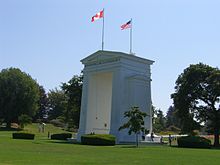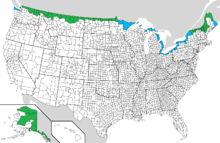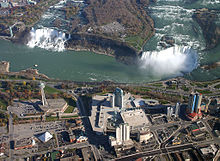Border between Canada and the United States

The border between Canada and the United States is 8,891 kilometers and 120 transitions the world's longest border between two states. This border, which is not militarily secured on either side, leads over land and short maritime sections in the coastal area of the Atlantic , Pacific , Arctic and Great Lakes . Of this, 2,487 kilometers go to the border between Canada and the US state of Alaska, which is separated from the main part of the USA in the north . The southern border of Canada to the United States of America alone measures 6404 kilometers, and to the west of the Canadian province of Ontario it essentially follows the 49th parallel .
history
The current border came about in 1783 with the Treaty of Paris , which ended the war between the Kingdom of Great Britain and the breakaway Thirteen Colonies that formed the United States . The Jay Treaty of 1794 created the International Boundary Commission to monitor and map the boundary. Disputes about the interpretation of the demarcation led to the so-called Aroostook War in 1838 and, as a consequence, to the Webster-Ashburton Treaty in 1842 , with which the border between Maine and New Brunswick , or the province of Canada, was more clearly defined. The expansion of both British territory in North America and the United States westward is west of the Lake of the Woods to the Rocky Mountains by the London Treaty of 1818 . A border dispute over Oregon in 1844 during the presidency of US President James K. Polk led to the demand for the US northern border west of the Rockies to be established at latitude 54 ° 40 'north (in connection with the southern border of the Alaska Territory Russia ), but the British wanted a border that follows the Columbia River to the Pacific . The dispute was settled with the Oregon Compromise in 1846, with which the 49th parallel was established as the boundary line through the Rocky Mountains. After the Pig Conflict of 1859, Canada ceded the San Juan Islands to the United States. In 1903, a joint tribunal of the United Kingdom, Canada and the United States in the Alaska border dispute established the border between Canada and Alaska. In 1925, the International Boundary Commission was upgraded to a permanent organization, charged with exploring and mapping the border, maintaining the boundary markers (or buoys ), and removing undergrowth and higher vegetation in a six meter (or 20 foot ) strip on either side of the Border line is.
safety
Widely known as the world's longest undefended border , the border is actually guarded, but by police rather than military personnel. The relatively low level of security measures is in stark contrast to the situation on the United States-Mexico border , which is only one-third the length of the US-Canada border and is actively controlled by US Customs and immigration services to Mexicans and to prevent other migrants from entering the United States illegally.
After September 11, 2001 , security controls along the border were significantly tightened on both sides, both in heavily populated and rural areas. Both states exchange detailed and extensive information on tactical and strategic reconnaissance. But it is a common misconception that the 19 terrorists involved in the September 11, 2001 attacks crossed the Canadian border into the United States.
US and Canadian border residents who own property directly on the border are required to report the establishment of border crossings on their land to the relevant authorities and these are monitored by the International Boundary Commission. Fences or vehicle barriers are erected where necessary. All people crossing the border must report to the relevant customs and immigration authorities in both countries. In remote areas where manned border crossings are not available, there are hidden sensors on roads and also in the forests near border crossings or on trails and railways; but there are not enough border guards on both sides to check and stop every intrusion (see Michel Jalbert incident )
Portions of the international border pass through mountainous terrain or densely forested areas, but substantial sections pass through remote prairie, the Great Lakes, and the Saint Lawrence River . There are also maritime sections of the border in the Atlantic , Pacific and Arctic Oceans . The border divides the reservation of the Mohawk tribe Akwesasne . The current number of personnel responsible for border security on the US and Canadian sides is estimated at less than 1,000 people, mostly posted around the larger border crossings. By comparison, there are over 17,000 members of the U.S. Border Guard on the border between Mexico and the United States.
In recent years, Canadian authorities have the smuggling of cigarettes and firearms deplored by the United States to Canada and US officials importation of illegal drugs from Canada. People smuggling between the two countries is a current problem for border security and police authorities, but to a far lesser extent than on the border with Mexico. In July 2005, police arrested three men, including a 100-meter-long tunnel under the border between British Columbia and Washington had dug through to him to smuggle marijuana use. It was the first known tunnel of its kind on this border.
In the course of the Safe Third Country Agreement (STCA) of 2004, people who apply for asylum at the border crossings of both countries from the other country are rejected because they come from a safe third country . After more than 20,500 people illegally moved from the USA to Canada during the Trump administration in the USA in 2017 and applied for asylum there without using regular border crossings, representatives from both sides are discussing the possibility of changing the STCA agreement in order to also to be able to reject asylum seekers who gain access to Canada outside of regular border crossing points.
The regulation of traffic across the border
Canada and the USA do not form a single customs area, they are members of NAFTA , the North American free trade area. Citizens are allowed to cross the border with a passport without a visa. The border has 120 border crossings, long stretches run through forests and national parks. The border troops are equipped with four-wheel vehicles, sometimes with horses. In the economic areas of Ontario, Michigan, New York and Detroit, around 570,000 trucks cross the border every month.
In order to speed up the border formalities for trade, transport companies can u. sign up for the Free and Secure Trade Program (FAST). They are then "Authorized Economic Operators" who can arrange customs clearance at least one hour before the crossing, for example via the electronic eManifest system. A barcode is issued for fast border clearance. The US electronic customs system Paps and the Canadian Pars system also serve this purpose. Trucks registered in this way pass the border on extra FAST lanes. For example, the waiting time at the border in Detroit over the Ambassador Bridge for unregistered trucks is usually 20 minutes.
Cars can cross the border at many points in 25 seconds if the driver has registered with the electronic Nexus program. The driver then receives a biometric ID to replace a passport, which an RFID reader at the station scans. Such cars cross the border on special Nexus car lanes, if any.
All border crossings between Canada and the USA, through which the main traffic runs, are generally visible and clearly secured border installations. In winter there are even controls on the banks of frozen lakes.
Important border bridges and border tunnels
From east to west:
- Clair – Fort Kent Bridge - Clair, New Brunswick and Fort Kent (Maine)
- Seaway International Bridge - Cornwall, Ontario and Massena, New York
- Ogdensburg-Prescott International Bridge - Ogdensburg (New York) and Johnstown (Ontario)
- Thousand Islands Bridge - Wellesley Island, New York and Hill Island, Ontario
- Queenston-Lewiston Bridge - Queenston, Ontario and Lewiston, New York
- Whirlpool Rapids Bridge - Niagara Falls, Ontario and Niagara Falls, New York
- Rainbow Bridge - Niagara Falls, Ontario and Niagara Falls, New York
- Peace Bridge - Fort Erie (Ontario) and Buffalo ( New York )
- Ambassador Bridge - Windsor (Ontario) and Detroit ( Michigan )
- Michigan Central Railway Tunnel - Windsor, Ontario and Detroit, Michigan
- Detroit-Windsor Tunnels - Windsor, Ontario and Detroit, Michigan
- Blue Water Bridge - Port Huron, Michigan and Sarnia, Ontario
- Sault Ste. Marie International Bridge - Sault Ste. Marie (Michigan) and Sault Ste. Marie (Ontario)
- Baudette-Rainy River International Bridge - Baudette, Minnesota and Rainy River, Ontario
- Fort Frances – International Falls International Bridge - Fort Frances and International Falls (Minnesota)
- St. Clair Tunnel - Port Huron, Michigan and Sarnia, Ontario
Remaining border disputes
- Machias Seal Island and North Rock (Maine / New Brunswick)
- Dixon Entrance (Alaska / British Columbia)
- Beaufort Sea (Alaska / Yukon )
- Strait of Juan de Fuca (Washington / British Columbia)
Other border crossings (airports, seaports)
The United States maintains immigration facilities, known as United States border preclearance , at Canadian airports with international flights to the United States ( Calgary , Edmonton , Kelowna , Montréal , Ottawa , Saskatoon , Toronto , Vancouver , Winnipeg , and Halifax ). This allows flights originating in Canada to land at US airports without treatment on entry as international flights. Similar regulations exist at major Canadian seaports that handle sealed direct shipments to the United States. Canada does not maintain such facilities as the number of respective departures to Canada is lower due to the greater selection of origin airports. When passengers board the Amtrak Cascades for Seattle at Vancouver Central Station , they have to pass through passport control and their luggage screened before they can board the train, which does not stop at the border. This does not happen with the heavily frequented connections between Montreal (The Adirondack) or Toronto (The Maple Leaf) and New York City , as these rail connections have intermediate stops in the section from Montreal or Toronto to the border. Instead, passengers have to complete the border formalities at a stop at the border. Various ocean ferries operate between the provinces of New Brunswick or Nova Scotia and Maine , as well as between British Columbia and Washington or Alaska. There are also several ferry services on the Great Lakes between Ontario and the US states of New York and Ohio .
Cross-border airports
A special feature of the Canadian-US border is that a total of six airfields are on the territory of both countries.
These airfields are:
- the Piney Pinecreek Border Airport in Manitoba and Minnesota . The runway, which runs in a northwest or southeast direction, crosses the border. The airfield also has two ramps, one in the United States and one in Canada
- the International Peace Garden Airport in Manitoba and North Dakota . The runway is entirely on US territory, but there is a runway to Canada to get to Canadian customs
- the Coronach / Scobey Border Station Airport in Saskatchewan and Montana . The runway, which is laid out in an east-west direction, lies exactly on the Canadian-US border
- the Coutts / Ross International Airport in Alberta and Montana. As with the Coronach / Scobey Border Station Airport, the runway is exactly on the border
- the Del Bonita / Whetstone International Airport in Alberta and Montana. As with the two previous airports, the runway runs exactly on the Canadian-US border
- the Avey Field State Airport in Laurier , the US state of Washington . Most of the private airfield is on US territory, but about 100 meters of the runway is on Canadian soil in the province of British Columbia . Both US and Canadian customs offices are located here.
Regulations for indigenous people
On the basis of intergovernmental agreements, the members of indigenous groups , if their historical territory z. B. extends over both national states, easier transit options, usually without special passport control. The possible abuse by smugglers or, in extreme cases, by serious criminals who evade punishment by simply crossing borders is thematized in a novel-like form by Wajdi Mouawad in Anima . The leaders of indigenous groups are aware of the problem, they take their own criminal and prosecution measures, and they try to keep it as small as possible so as not to endanger the privilege.
literature
- Lawrence BA Hatter: Citizens of Convenience: The Imperial Origins of American Nationhood on the US-Canadian Border. University of Virginia Press, Charlottesville 2016, ISBN 978-0-8139-3954-4 .
Individual evidence
- ↑ Canada & The United States: Bizarre Borders Part 2 - YouTube. In: youtube.com. Retrieved December 22, 2013 .
- ↑ Archive link ( Memento of the original from February 17, 2008 in the Internet Archive ) Info: The archive link was inserted automatically and has not yet been checked. Please check the original and archive link according to the instructions and then remove this notice. Archive link ( Memento of the original from September 28, 2006 in the Internet Archive ) Info: The archive link was inserted automatically and has not yet been checked. Please check the original and archive link according to the instructions and then remove this notice.
- ↑ Terence P. Jeffrey: Administration Will Cut Border Patrol Deployed on US-Mexico Border ( Memento of the original from September 28, 2009 in the Internet Archive ) Info: The archive link was automatically inserted and not yet checked. Please check the original and archive link according to the instructions and then remove this notice. . In CNS News of September 24, 2009, accessed April 23, 2011
- ^ CNN : Drug tunnel found under Canada borde ; July 21, 2005
- ↑ Jillian Kestler-D'Amours: "Asylum seekers may face tougher hurdles to enter Canada" Al Jazeera from May 3, 2018
See also
Web links
- International Boundary Commission
- Indepth: It's a fine line - Disputing boundaries CBC News Online, Oct. 11, 2005
- 1994 trip from Lake of the Woods to the Continental Divide





